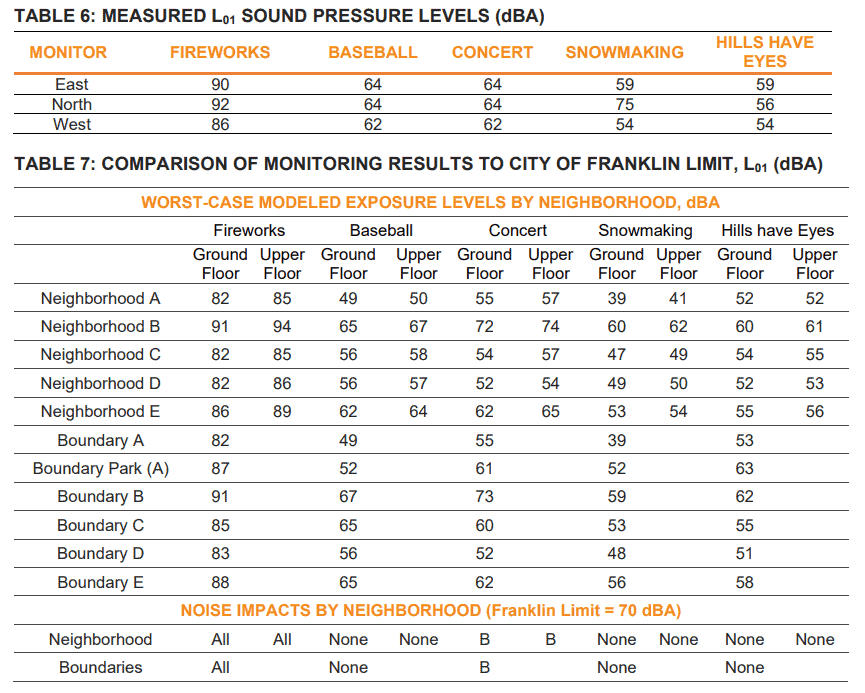This is part 2 in a series of Wisconsin Right Now investigative stories exploring The Rock Sports Complex development in Franklin.
Neighbors say the sounds have destroyed their quality of life for years, but officials have done nothing about it.
The Rock’s owners refused to allow a sound study team commissioned by the Milwaukee County Board access to their facilities or sound monitors, but Franklin city officials eventually revealed that two of the development’s three monitors weren’t operable, and the remaining one hadn’t been calibrated for four years.
That’s according to the new sound study and attorney’s summary accompanying it.
The study found that the city isn’t proactively enforcing sound concerns at the Rock but rather places the burden on citizens who live nearby “to enforce the noise standard” by making complaints. Franklin officials then enforce complaints by gathering “unreliable” data from the inoperable or non-calibrated monitors, using a flawed ordinance and development agreement that makes violations almost impossible to achieve, the documents say.
The City of Franklin “had to a large extent left noise producing activities at the ROC virtually unregulated,” resulting in a “significant number of complaints,” wrote attorney Dennis M. Grzezinski, who worked alongside the RSG sound study team.
The attorney’s summary of the sound monitoring study found that various activities at the Rock “are clearly capable, as a result of their volume and nature, to annoy, irritate, and disrupt the quiet enjoyment, and disturb the sleep, of residents in Franklin and Greendale neighborhoods adjacent to the ROC — during both daytime and nighttime hours.”
The developers refused to say why the monitors weren’t working, according to the documents, which were obtained by Wisconsin Right Now in advance of their presentation Wednesday to the Milwaukee County Board.
“The RSG team did not receive permission to access ROC facilities,” says the study, which was commissioned after the city and county “received numerous complaints regarding noise” from neighbors over multiple years.
The study cost taxpayers $200,000.
The Rock’s 2017 development agreements with the county require the developers to make data from three required sound monitors available to the city or county by request, the documents say.
We reached out twice to the developer, Mike Zimmerman, for comment. He did not respond. County Supervisor Patti Logsdon and Franklin Alderman Jason Craig have been helping residents with their concerns.
The attorney also questioned whether the development agreement and Franklin ordinance were inconsistent with the city’s “public nuisance” ordinance, and called for a moratorium on future construction at the Rock until an even more comprehensive sound study can be conducted.

The study confirmed a persistent complaint from neighbors; that the Rock has speakers directed toward a residential neighborhood. That’s the Hawthorne neighborhood, the same street where we met with upset neighbors on Friday. “It is not clear what steps the City or the County have taken to ensure that this provision of the development agreement has been complied with,” the attorney wrote.
The study recommends that the developer turn speakers away from residential neighborhoods, noting this would actually save “energy and costs to the operator.”
With the Rock’s data “unreliable,” the study team erected its own monitors. Some sounds from the sports and entertainment complex exceeded Franklin and Greendale ordinance noise limits for residential neighborhoods, the documents say.
Flawed Ordinance Wording & Enforcement
However, the City of Franklin’s flawed ordinance and enforcement practices made it almost impossible for the Rock to be found in violation of sound requirements, even as neighbors continued to complain that the noise from events were destroying their quality of life, keeping their children up on school nights, and making it impossible to enjoy an evening on their backyard patios, the documents say.
For example, until recently, Franklin did not consider the Rock to be in violation of sound ordinances unless a sound exceeded its ordinance limit for 30 minutes straight, even though there was no basis in city ordinances for this, the study said. That’s a bit like a police officer saying that a person would have to speed for 30 minutes straight to get a speeding ticket.
“A musical concert could consist of a series of songs that are consistently louder than the limits and the concert could go on for several hours and not be treated as a violation if there was even a short break between one song and the next or a relatively quiet period within a song,” the study says.
Despite this tough standard, the Rock did have a material violation in recent years, the audit revealed. The violation “occurred for more than 30 minutes, which then qualifies the occurrence as a material violation under the County’s agreements with the owner/developer,” a 2021 audit said.
Asked whether there would be any penalties or fines, the city of Franklin told County officials that a notice was sent to the Rock, but the city “did not send a citation to appear in court because the fine would have amounted to a slap on the wrist,” according to that audit, which predated the sound study.
Until recently, Franklin’s practice was to only enforce violations if the sound “continuously exceeded” 79 decibels “for a duration of 30 minutes or more,” the study said, even though the ordinance limits start at 70 and don’t mention a 30-minute duration.
Furthermore, the 70 to 79-decibel limit in the ordinance is much higher than neighboring Greendale’s and World Health Organization recommendations on when sound becomes a serious annoyance, the study says.
World Health Organization guidelines for avoiding serious and moderate annoyance are set at 55 and 50 decibels. The sound study found that, although few sounds outside fireworks exceed 70 decibels, various events do exceed the WHO and Greendale levels, and, in some cases, such as Milwaukee Milkmen baseball games with concerts, the events occur frequently.
In some cases, noise exceeds Franklin or Greendale ordinance limits in neighborhoods, the study found, citing fireworks shows and Umbrella Bar concerts. In some neighborhoods they exceed standards to protect against “harm from low-frequency noises,” the attorney’s summary says.
The county development agreement did not “specifically set out a noise limit,” and the city’s code does not specify “the type of sound level or metric,” the summary says.
In contrast, the Village of Greendale, which also has neighborhoods near the Rock, has a much more detailed ordinance that breaks sound down by different noise and neighborhood types (like residential versus manufacturing and persistent sound vs. intermittent). Greendale’s sound limits are much lower than Franklin’s, ranging from 45 to 55 at night (between 8 p.m. and 7 a.m.) in residential neighborhoods to 60 for fireworks.
Franklin does have an ordinance prohibiting public nuisances, but the study found it was not applied to the Rock concerns. It defines public nuisances as acts or conditions that “substantially annoy, injure or endanger the comfort, health, repose or safety of
the public.”
The attorney found that excessive noise is recognized in Wisconsin “as a potential cause of a public nuisance,” and noted that Wisconsin case law indicates that noisy activities may “constitute public or private nuisances and result in injunctions and liability for damages.”
Concerns About the Monitors Detailed
According to the attorney’s summary and the study, two noise monitors at the Rock were “inoperative” during the sound study and “apparently have been so for a long time, perhaps approaching a year.” As a result of the “lack of cooperation from the operator, there is no information as to why this has been so.”
The fact that one monitor was not calibrated for almost four years is “insufficient,” the study says, adding that field calibration should occur monthly and lab calibration every two years.
“More recently, the East and West monitors were apparently once again made operational but were not downloading their results to be accessed by City staff,” the attorney noted, urging the city and Milwaukee County to take steps to ensure that the Rock keeps the monitors fully operable and “properly calibrated.”
The study found that some activities created noise audible “as far as two miles away.”
The attorney’s summary says that the city and the county should require monthly reporting of sound data from the Rock and ensure the monitors are working.
The city only listens to 10 seconds of recordings if a complaint is received, but the study said this is not adequate. As a result of the ordinance flaws, the documents say it “is no surprise that no violations have been identified, despite regular complaints from residents.”
Fireworks exceed the noise ordinance but no variance was granted for them, the documents say.
The concerns about monitors date back years. A 2021 audit also raised concerns that the east monitor was not functioning; an August 2023 status report by auditors says the developer told the county it was “never non-functional.” The discrepancy is not explained.
Although the development agreement states that bands at the Umbrella Bar shall use a “dedicated sound system” installed by the developer to control sound levels and direction, bands are using their own amplifiers, the study found.
The attorney suggested that monitoring data be placed online to “provide greater transparency to the public.”
The study says “noise-generating events” at the Rock include the Milkmen games, live amplified music from the Umbrella Bar, fireworks, the “Hills Have Eyes” Halloween event, and snowmaking at the Rock Snowpark.
It also emphasizes that decibel levels alone should not be the sole judge of noise concerns, suggesting that the ordinance be rewritten to incorporate penalties for speech or music content, noting that some sounds affect neighbors more, singling out chainsaw sounds from the Halloween event.
The county development agreements with the Rock date back to 2017 when it was built on a former landfill. The three sound monitors were installed as a result of noise requirements in the agreements.
The sound study team also commenced a public meeting with neighbors in August 2023, writing that they “all reported being disturbed by sound from the ROC.”
Sound Level Suggestions
A level of 70 decibels is “not appropriate” to avoid sleep disturbance or to be compatible with adjacent neighborhoods, the study found.
The study team recommends the City of Franklin ordinance be changed in residential areas to 50 for perpetual or continuous sounds, 60 for intermittent, and 70 for impulsive, like fireworks. The ranges drop to 45, 55, and 60 at night.

Events with speech and or music should have lower requirements (45, 55, 65) decibels during the day) or nighttime of 40, 50, 55, the study suggests.
The current Franklin ordinance also doesn’t distinguish between day and night hours.
There were at least six fireworks shows from June through August. Some events go as late as midnight.
North monitor sound levels were highest. Decibels ranged from 55 for baseball to 59 for baseball and concerts. Fireworks were 88 and Hills Have Eyes was 56, the study found.
The study was conducted for a six-month period through January 2023.
The study said the Milky Way Drive-in Theater and a Luxe golf facility do not “substantially contribute” to the sound environment in residential areas.
The sound study also confirms other issues raised by neighbors. For example, it found that game announcements, music, and “moo” sounds were “clearly audible and distinguishable” in one neighborhood, and sound levels increased in all neighborhoods around 9 p.m. when live music starts at the Umbrella Bar. Sounds from a summer concert series are heard in some neighborhoods, and the noises from the Halloween event traveled more than a mile.
Although the baseball sound levels only added two to four decibels beyond background noise, the sounds “were distinctly noticeable in the Hawthorn Neighborhood to the west, either because they rose and fell (for example, cheering at baseball games) or they had a distinct sound (like music or speech from the public announcement system),” the study found.
The study notes that there are “no County, State, or Federal noise standards applicable to the ROC.”
Franklin Police Chief Rick Oliva told us in an email, “I’m sympathetic to the complaints of the neighbors but the police department has been unfairly criticized for ‘not doing anything’ about the noise. Although people have pointed out city ordinances that state noise should be at lower levels, city officials have determined the permitted level is 79 decibels (although they changed it in May of last year to 79dbl from 7:00AM-10:00PM and 74dbl from 10PM to 7:00AM.)”
Table of Contents












